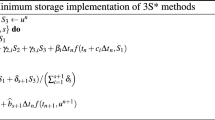Abstract
The direct numerical simulation of transitional and turbulent incompressible flows is an area that is increasing with the advance in computational resources. Code parallelization has became a useful tool in these simulations. In the present paper the unsteady two dimensional Navier–Stokes equations are used as physical model. Tollmien–Schlichting waves propagating in a Poiseuille flow is adopted as test case. Three frequencies showing different behavior according to the linear stability theory (LST) are used: unstable, nearly neutral and stable waves. The parallelization is done via domain decomposition in the streamwise direction. The time derivative is integrated by a classical fourth-order Runge–Kutta method. High-order compact finite difference schemes are used for the spatial derivatives discretization. The Poisson equation is solved by multigrid methods. The present paper explores different parallelization techniques for solving the tridiagonal system, and the multigrid method. The results are compared with LST, and also between the different parallel strategies to show the advantages and disadvantages of each one.





















Similar content being viewed by others
References
Kim W, Menon S (1999) An unsteady incompressible Navier–Stokes solver for large eddy simulation of turbulent flows. Int J Numer Method Fluids 31:983–1017
Lele SK (1992) Compact finite difference schemes with spectral-like resolution. J Comput Phys 103:16–42. doi:10.1016/0021-9991(92)90324-R
Hirsh RS (1975) Higher order accurate difference solutions of fluid mechanics problems by a compact differencing technique. J Comput Phys 19(1):90–109. doi:10.1016/0021-9991(75)90118-7
Wray A, Hussaine MY (1994) Highly accurate compact methods and boundary conditions. Proc Royal soc Lond A392:373–389
Kloker MJ (1998) A robust high-resolution split-type compact FD-scheme for spatial direct numerical simulation of boundary-layer transition. Appl Sci Res 59(4):353–377. doi:10.1023/A:1001122829539
Mahesh K (1998) A family of high order finite difference schemes with good spectral resolution. J Comput Phys 145:332–358. doi:10.1006/jcph.1998.6022
de Souza LF, de Mendonça MT, de Medeiros MAF (2005) The advantages of using high-order finite differences schemes in laminar-turbulent transition studies. Int J Numer Methods Fluids 48:565–582. doi:10.1002/fld.955
Zhang J (1996) Acceleration of five-point red-black Gauss–Seidel in multigrid for Poisson equation. Appl Math Comput 80:73–93. doi:10.1016/0096-3003(95)00276-6
Zhang J (1997) Residual scaling techniques in multigrid, I: equivalence proof. Appl Math Comput 86:283–303. doi:10.1016/S0096-3003(96)00194-4
Spitaleri RM (2000) Full-fas multigrid grid generation algorithms. Appl Numer Math 32:483–494. doi:10.1016/S0168-9274(99)00064-1
Gupta MM, Kouatchou J, Zhang J (1997) Comparison of second and fourth order discretizations for multigrid Poisson solvers. J Comput Phys 132:226–232. doi:10.1006/jcph.1996.5466
Velde EFV (1994) Concurrent scientific computing. Springer, New York
Brandt A (1977) Multilevel adaptative solutions to boundary values problems. Math comput 31:333–390
Huang Y, Guia U (1992) A multigrid method for solution of vorticity-velocity form of 3-D Navier–Stokes equations. Commun Appl Numer Methods 8:707–719
Fish J, Pandheeradi M, Belsky V (1995) An efficient multilevel solution scheme for large scale non-linear systems. Int J Numer Methods Eng 38:1597–1610
Zhang J (2002) Multigrid method and fourth-order compact scheme for 2D Poisson equation with unequal mesh-size discretization. J Comput Phys 179:170–179
Ge Y (2010) Multigrid method and fourth-order compact difference discretization scheme with unequal meshsizes for 3D Poisson equation. J Comput Phys 229:6381–6391
Henniger R, Obrist D, Kleiser L (2010) High-order accurate solution of the incompressible Navier–Stokes equations on massively parallel computers. J Comput Phys 229:3543–3572
Buckeridge S, Scheichl R (2010) Parallel geometric multigrid for global weather prediction. Numer Linear Algebra Appl 17:325–342
John V, Tobiska L (2000) Numerical performance of smoothers in coupled multigrid methods for the parallel solution of the incompressible Navier–Stokes equations. Int J Numer Methods Fluids 33:453–473
Fasel HF, Rist U, Konzelmann U (1990) Numerical investigation of the three-dimensional development in boundary-layer transition. AIAA J 28:29–37. doi:10.2514/3.10349
Souza LFd (2003) Instabilidade centrífuga e transição para turbulência em escoamentos laminares sobre superfícies côncavas. Ph.D. thesis, Instituto Tecnológico de Aeronáutica
Acknowledgments
The authors acknowledge the financial support received from FAPESP under grants 2009/03208-6, 2010/00880-2, 2011/08010-0 and 2013/00553-0.
Author information
Authors and Affiliations
Corresponding author
Additional information
Technical Editor: Francisco Ricardo Cunha.
Rights and permissions
About this article
Cite this article
Rogenski, J.K., Petri, L.A. & de Souza, L.F. Effects of parallel strategies in the transitional flow investigation. J Braz. Soc. Mech. Sci. Eng. 37, 861–872 (2015). https://doi.org/10.1007/s40430-014-0221-4
Received:
Accepted:
Published:
Issue Date:
DOI: https://doi.org/10.1007/s40430-014-0221-4




